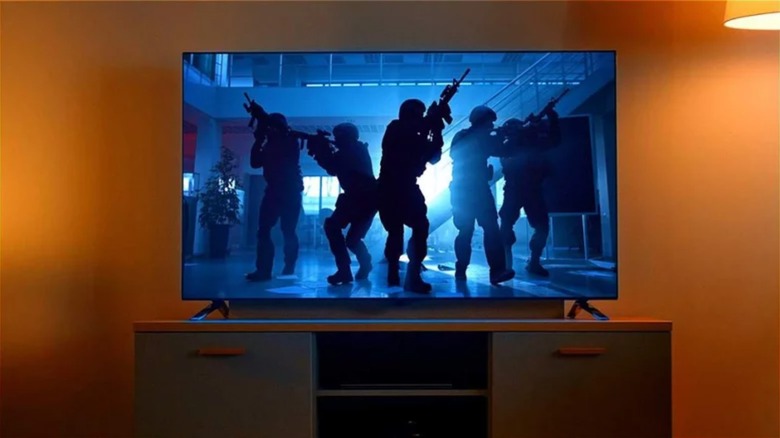What's The Difference Between 4K And UHD?
We may receive a commission on purchases made from links.
If you've been sitting on the fence for a new TV, monitor, or any other display device online, it's likely you've heard mentions of "4K" and "UHD," or Ultra High Definition — often in the same sentence. Despite being different, the terms 4K and UHD are used interchangeably to market a phenomenal viewing experience on screens or devices such as a projector. 4K is more mainstream than ever, and ads make the buying choices for both even more confusing. As such it's worth knowing the difference between 4K and UHD.
4K and UHD have different origins. While UHD is used in the display equipment industry and for broadcast, 4K was originally used in the context of cinema and video production. As Teufel Audio notes, a UHD TV has fewer pixels horizontally and therefore, cannot achieve the same resolution as a 4K TV set. To elaborate on the difference, let's break it down even further.
4K vs. UHD Resolution
UHD resolution implies 3840x2160 pixels (or 8,294,400 pixels in all), which is exactly four times the number of pixels we find in a Full HD (1080p) display, according to the Teufel Audio post linked above. The multiplicity is probably the reason UHD comes to be replaced by 4K so easily in the common lexicon.
4K, on the other hand, denotes a resolution of 4096x2160 pixels. Due to this vertical and horizontal arrangement of pixels, the standard is sometimes called 4K2K. 4K has wider pixelation than UDH because 4K digital cinema projectors must support films in both "Flat" and "Scope" aspect ratios, as per RGB Spectrum. The Flat configuration has an aspect ratio of 1.85:1 (which means, for each unit of the screen width, there are 1.85 units in length). Meanwhile, a Scope configuration uses a 2.39:1 aspect ratio. Therefore, a movie in a Flat ratio has a typical resolution of 3996x2160 pixels whereas Scope has a resolution of 4096x1716 pixels. In simpler terms, Scope is wider but shorter in length than a Flat orientation.
The decision between using Flat and Scope is usually that of the film's director and producer but we can expect newer movies to rely on Scope more than Flat. As noted by one kind Imgur user, Scope is normally used in large-scale epics or action films — with anything related to "The Avengers" being an exception.
Should the difference between 4K and UHD impact your choice?
Whether the technical differences between 4K and UHD should impact your buying decision depends on how you plan to use your screen. If you are buying a TV or display device specifically for watching movies, you'll likely end up with UHD because that's how most TVs from major brands like Sony are marketed and sold. Since the term 4K has a higher recall than Ultra High Definition or UHD, brands prefer to market TVs with UDH resolution as 4K. However, as we mentioned above, that shouldn't impact your decision to buy a TV.
More importantly, it can be a challenging task to find a TV that supports actual 4K TV. Finding a PC monitor that supports a 4K2K resolution is relatively easier but those may be optimized for uses like gaming, productivity, and content editing instead of just entertainment. You are likely to find way more choices for projectors with 4K2K resolution but projectors have their own limitations, and are not ideal for basic living room entertainment.
Most of your content is UHD and not 4K
Many online content streaming services also refer to UHD content as 4K. Netflix, for instance, offers UHD content that is marketed as 4K. Notably, 4K content is only available on the Premium plan for which you have to pay $20 a month. Meanwhile, you do not need a separate plan to watch 4K content on Apple TV+ ($5 per month) or Amazon Prime Video ($9 per month). That said, you will need hardware that supports 4K content — and as noted above, that isn't always easy to come by, which often makes these upgrades not worth the cost.
Additionally, if you are still relying on your old 4K Blu-ray player for high definition movies, a UHD will just suffice because a 4K Blu-ray disc also stores movies in a resolution of 3840X2160 pixels, as Samsung notes.
At the same time, some old content like classic movies may not be readily available in native UHD or 4K quality. Some TVs rectify this shortcoming by artificially upscaling content from a lower resolution to UDH — 3840×2160 pixels, as noted by RTINGS. In such a scenario, you will be better off with a UDH display and will not need a 4K display.
True 4K is an expensive affair
Image: Eizo
Buying a UHD TV would not only be the easiest but also the most economical choice based on the above. Since true 4K displays are mostly used by professionals in the photography or film business, they are designed to offer high color accuracy and low latency, which also means they are priced way higher than UHD displays. For instance, a BenQ EW2780U 27-inch UHD monitor sells for $450 on Amazon while at the same time, a truly 4K monitor from the same company, the BenQ SW271C 27-inch 4K monitor, is listed at $1600 on Amazon. Meanwhile, an Eizo ColorEdge CG319X 32-inch 4K monitor that is used for film editing goes for upwards of $5700.
The decision between 4K and UHD really boils down to your priorities. If you want to watch movies for entertainment, you are better off with a UHD display device. A true 4K display only makes sense if you either edit photos or film professionally or are a true cinema connoisseur who just wants absolutely no compromise in their experience. But do remember, this experience comes with a heavy price.
If you want to avoid this confusion and just buy a device that is adaptive to all forms of content, then you can quite conveniently choose to ignore the nuances and get the one that you like — even if it is branded as a 4K UHD TV. The result will be the same high-quality resolution and ultra-modern viewing experience.




